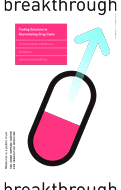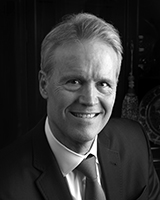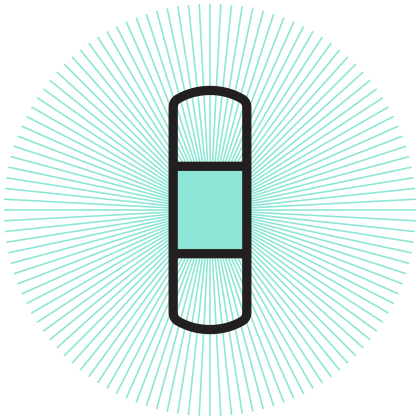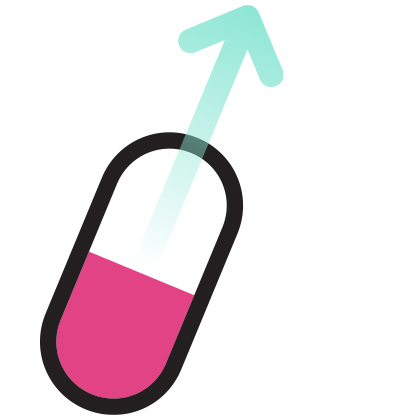

David B. Hellmann,
MD, MACP
It’s hard to believe that more than 14 years have passed since the Center for Innovative Medicine was launched at Johns Hopkins Bayview Medical Center. As we move well into our second decade, I’m thrilled beyond measure to see CIM’s “ripple effect.” Increasingly, our people and programs are having an impact well beyond Bayview, improving the health and lives of people across our city, our state, our nation – and beyond.
For evidence, look no farther than this issue’s cover story about the advocacy efforts of CIM scholar Jeremy Greene. A primary care physician and noted director of the Institute of the History of Medicine at Johns Hopkins, Jeremy has become the “go-to” expert for state and Congressional legislators who are working to bring down the costs of prescription drugs. The current state of affairs is truly alarming. As Jeremy points out, the annual cost of insulin for type 1 diabetes has nearly doubled in recent years, putting the medication out of reach for many who need it. By taking the long view, Jeremy is bringing a well-informed voice to the national conversation about this important issue.
In a similar fashion, the work of addiction expert Michael Fingerhood has gained the attention of freshman members of the U.S. House of Representatives, who visited earlier this spring, touring sites (such as Bayview’s Emergency Department) where Mike and his team have scaled up innovative programs to better treat patients with substance use disorder. Closer to home, Johns Hopkins University president Ronald Daniels has now tapped Mike, a member of the Miller Coulson Academy of Clinical Excellence, to lead an ambitious, universitywide effort to address opioid addiction, which builds on groundwork already laid by CIM’s “5 in 10” Initiative. With Mike’s leadership, I’m more confident than ever that we’ll be able to make a positive impact – and soon – in the lives of those grappling with debilitating addiction.
I’m excited by the ever-widening impact that CIM is having in our continued efforts to make medicine a public trust – and very grateful for your support.

Aliki Perroti Professor of Medicine;
Vice Dean, Johns Hopkins Bayview Medical Center;
Chairman, Department of Medicine
Don Willett May 7th, 2019
Posted In:
 About 10 years ago, clinical psychologist Neda Gould was a postdoctoral fellow working on the Burn Unit at Johns Hopkins Bayview when she heard about a compelling new course. It focused on teaching the basics of mindfulness as a tool for reducing stress. Intrigued, Gould enrolled, hoping the tools she learned could be used to help patients with burns who were suffering from post-traumatic stress disorder.
About 10 years ago, clinical psychologist Neda Gould was a postdoctoral fellow working on the Burn Unit at Johns Hopkins Bayview when she heard about a compelling new course. It focused on teaching the basics of mindfulness as a tool for reducing stress. Intrigued, Gould enrolled, hoping the tools she learned could be used to help patients with burns who were suffering from post-traumatic stress disorder.
“The course was transformative for me. It allowed me to see the world in a whole different way,” says Gould today. “I’m a pretty driven, high-strung individual, but mindfulness opened my eyes to a whole new experience of living in the present moment. I now have the capability to be with my stress and work with it, as opposed to running from it.”
Gould completed the 40-hour stress reduction program created by Jon Kabat-Zinn, known as mindfulness-based stress reduction (MBSR), and subsequently earned certification to teach MBSR. Since then, she says, she’s “never looked back.”
Over the last few years, Gould has brought mindful-ness training to patients and clinicians across Johns Hopkins, including patients at the Amos Food, Body and Mind Center – and she’s seen countless lives improved through this practice. Most recently, with funding from the Center for Innovative Medicine, she’s expanded her classes to include hospital staff members at the Johns Hopkins Bayview Medical Center.
“Research has shown actual changes in brain structure and function following the practice of mindfulness/meditation. It’s pretty remarkable that we have the power within our minds to shift these bodily processes.”
– Clinical psychologist Neda Gould
Gould points to solid research showing that mindfulness/meditation decreases levels of stress, anxiety, depression and chronic pain. The practice has also been found to improve immune function and reduce hypertension. “Research has shown actual changes in brain structure and function following the practice of mindfulness/meditation,” says Gould. “It’s pretty remarkable that we have the power within our minds to shift these bodily processes.”
The courses she offers vary in terms of focus, format and length. Most often, participants meet for the full MBSR course for 2.5 hours a week over eight weeks. She begins in the classroom, talking about the science behind mindfulness. In subsequent sessions, she covers meditation practices, leading participants through breathing exercises, gentle movement and yoga, and walking meditation. The capstone is a full-day retreat for silent meditation.
Participation has far exceeded expectation, she says, and underscored the reality that employees at Johns Hopkins are hungry for ways to decrease stress, reduce burnout and live happier lives. Whenever a new mindfulness course is announced, she says, “my inbox is flooded by people who want to enroll.”
Until recently, enrollment was limited to university employees. In January, thanks to funding from David Hellmann and the Center for Innovative Medicine, she was able to open the course to non-university employees. The winter course, offered for free with this funding, drew a wide range of hospital employees: physical and occupational therapists, nurses, research coordinators and support staff members.
Participation has far exceeded expectation…and underscored the reality that employees at Johns Hopkins are hungry for ways to decrease stress, reduce burnout and live happier lives.
“There is so much hierarchy in the hospital system,” Gould observes. “One of the things I love about these courses is that when we come into this room, this peaceful place that is nonjudgmental, there is such a sense of equality and connectedness. It’s a magical thing to witness.”
With additional funding, Gould would love to expand her mindfulness offerings to even more Johns Hopkins clinicians and staff members. “It’s a huge gift to those who participate,” she says. “This is where my heart is, and my hope is that this becomes my full-time focus at Johns Hopkins.”
Don Willett May 7th, 2019
Posted In:
 When congressional staffers in both the U.S. House and Senate began to put together plans for investigating the rising costs of prescription drugs, and insulin in particular, they drew on the ex-pertise of Johns Hopkins internist and Center for Innovative Medicine (CIM) member Jeremy Greene.
When congressional staffers in both the U.S. House and Senate began to put together plans for investigating the rising costs of prescription drugs, and insulin in particular, they drew on the ex-pertise of Johns Hopkins internist and Center for Innovative Medicine (CIM) member Jeremy Greene.
Over the past several years, Greene has testified repeatedly before committees of the U.S. House and Senate and made repeated trips to Capitol Hill to share his wisdom on this crucial issue. He also worked with the attorney general of Maryland to put forward a bill to make price gouging of prescription drugs illegal in the state. (The bill was passed but was ultimately struck down in the courts on appeal.)
Greene’s insights are particularly valued because he takes the long view: In addition to treating patients as a primary care physician at the East Baltimore Medical Center, he is a noted medical historian and the William H. Welch Professor of the History of Medicine and director of the Institute of the History of Medicine at Johns Hopkins.
And he’s written two books on the topic: Prescribing by Numbers (2009), which won the Rachel Carson Prize, and Generic: The Unbranding of Modern Medicine (2014). He is also an active member of the Johns Hopkins Drug Access and Affordability Initiative, an interfaculty effort focused on developing bipartisan policy recommendations to address pharmaceutical costs.
Thanks to the support of Leslie and Scott Jacobs, members of the CIM International Advisory Board, and Leslie’s brother Stephen Rosenthal, Greene was recently named as the Jacobs-Rosenthal CIM Scholar. “The knowledge and advocacy that Dr. Greene is bringing to this important issue is vital and very timely, and we are eager to support him in his work,” says Leslie Jacobs.
Indeed, says Greene, “The sense of urgency around rising drug prices has increased dramatically,” which is certainly warranted. Unless we pay more attention to making 20th-century drugs affordable, he warns, “we’re soon going to be living in a world where the 21st-century cures are only accessible to a tiny percentage of the population.”
Today’s troubles have been brewing for decades, he notes, using the current insulin crisis as an example. Insulin was discovered as a lifesaving treatment for diabetes nearly a century ago (1921) and patented two years later. “The patent was sold for $1 to make sure industry could produce high-quality medication that would be affordable for patients for years to come.”
Fast forward to the 2000s. Between 2012 and 2016, the annual cost of insulin for treating a type 1 diabetes patient nearly doubled – from $2,864 to $5,705. The jump has put the medication out of reach for some Americans with diabetes and prompted others to start rationing it, with potentially deadly consequences. “One out of four people requiring insulin for diabetes reports rationing or going without medicine due to cost,” Greene notes. “And more than 25 percent of life-threatening hospitalizations for diabetes in U.S. inner-city minority patients have been attributed to the inability to afford a regular supply of insulin.”
Key to rising insulin costs: There are no low-priced generic versions of insulin available. Instead, 99 percent of the global insulin market is controlled by three pharmaceutical giants – firms that can raise prices seemingly at will, “with no clear indication of why,” Greene says.
And it’s not just insulin. “In recent years, it’s become increasingly difficult to ensure that basic essential medicines, like albuterol for asthma or even IV saline, are available and affordable,” he says.
In a testimony before Congress last May, Greene ex-plained how we’ve arrived at a place in the U.S. where “old” drugs are increasingly unaffordable. Historically, a new drug is patent-protected during the first phase of its life, to reimburse its developers for the substantial costs of pharmaceutical innovation. Then it moves off-patent, a second phase during which competition brings prices down so that a supply of effective but affordable medications are widely available.
“But now we are finding that drugs enter a third, uncharted phase, where dwindling competition creates new monopolies,” Greene says, which has resulted in an “accelerated series of drug shortages and price hikes now affecting millions of Americans.”
Congressional concern over rising drug prices is not new, Greene points out. Since the 1950s, there’s been a surge of interest (and resulting congressional hearings) at least once a decade. “What fascinates me as a historian is that with every decade, the stakes are getting higher,” Greene says. “The limit of what is considered to be a mind-bogglingly unaffordable drug seems to leap each time by an order of magnitude.”
Inspired by concern for his patients at East Baltimore Medical Center, and buoyed by his colleagues involved in the Johns Hopkins Drug Access and Affordability Initiative, Greene vows to keep up his advocacy on this vital public health issue.
“Congress alone holds the power to illuminate how the hidden pieces in the puzzle of drug pricing actually fit together,” says Greene, “and to under-stand where the market is being distorted and provide evidence that will allow us to reach a true and lasting solution.”
Don Willett May 7th, 2019
Posted In:
 On a cold day last January, Johns Hopkins University President Ronald Daniels hopped in a car with Michael Fingerhood and began a three-hour tour of sites in East Baltimore. The two men visited places where the addiction specialist and his colleagues work daily to help local residents break the insidious hold of opioid use disorder.
On a cold day last January, Johns Hopkins University President Ronald Daniels hopped in a car with Michael Fingerhood and began a three-hour tour of sites in East Baltimore. The two men visited places where the addiction specialist and his colleagues work daily to help local residents break the insidious hold of opioid use disorder.
At Amazing Grace Church, the university president met 12 clients attending a Monday morning program for opioid treatment with buprenorphine (an under-the-tongue medication that blocks cravings for opioids). At Dee’s Place, a recovery and support center, President Daniels spoke with patients and staff members. Then it was off to the Comprehensive Care Practice at Johns Hopkins Bayview Medical Center, where over 650 individuals receive integrated primary care and treatment for opioid use disorder with buprenorphine. The final stop was the Emergency Department at Johns Hopkins Bayview, where every patient is now screened for substance use disorders, and addiction and peer recovery coaches are on hand to provide help and counsel, thanks in part to funding from the Center for Innovative Medicine.
“It was an amazing tour. President Daniels asked great questions. He talked with patients. He really wanted to understand what was going on in the community,” recalls Fingerhood, a member of the Miller Coulson Academy of Clinical Excellence.
Impressed with what he witnessed and with all the work that Fingerhood and his team have done over the past 25-plus years to build capacity for treating patients with opioid use disorder in Baltimore, President Daniels subsequently tapped him with an ambitious new charge: to lead a Johns Hopkins University -wide effort – involving researchers and clinicians at the schools of medicine, nursing and public health – to reduce opioid addiction in Baltimore.
The work, which will dovetail with the existing “5 in 10” initiative of the Center for Innovative Medicine, aims to reduce opioid-related deaths by 50 percent over five years in the hard-hit neighborhoods surrounding The Johns Hopkins Hospital and Johns Hopkins Bayview (see sidebar).
“In my proposal to President Daniels, I laid out a one-year timeline that is ultimately aimed at making buprenorphine available to all patients who need it,” says Fingerhood.
“We’ll also launch an education campaign to end the stigma surrounding opioid addiction and establish ‘bridge clinics’ that are open seven days a week, at both The Johns Hopkins Hospital and Johns Hopkins Bayview, to enable patients with opioid addiction to get the ongoing clinical care and support they need.”
It’s an ambitious plan with an aggressive timeline. President Daniels’ response? “Let’s make this vision happen!” says Fingerhood.
It’s been an eventful year for Fingerhood, whose ties to Johns Hopkins date back to the 1980s, when he came to Johns Hopkins Bayview for his residency. Just a few months earlier, he was honored as one of 10 American “heroes” at the inaugural Bloom-berg American Health Summit in Washington, D.C. Hosted by the Bloomberg American Health Initiative, the two-day event brought together innovators and policymakers from around the country who are creatively working to address some of the toughest challenges facing public health in the United States, including the opioid epidemic and gun violence.
At the event, which drew coverage from more than 50 media outlets around the world, including a live feed by C-SPAN, Fingerhood spoke about the tools that he and his colleagues at Johns Hopkins have put into place to combat opioid addiction, expand access to treatment and combat stigma.
These efforts are gaining the attention of national leaders. In March, a delegation led by U.S. Rep. David Trone (D-MD, 6th district) and Rep. Susan Wild (D-PA, 7th district) visited East Baltimore to tour many of the same sites President Daniels had visited just a few weeks earlier. Trone has created a bipartisan “freshman working group on addiction” that is composed of more than 40 newly elected lawmakers who are working to promote policies to end the opioid overdose crisis.
“We took them to the Emergency Department at Johns Hopkins Bayview to see firsthand the work we do, and they talked in some depth with our peer recovery coaches, who have a history of substance use disorder and are specially trained to meet new patients,” says Fingerhood. “Rep. Trone in particular was very engaged, and we talked for a long time after his tour. He asked: ‘What more should we be doing at a governmental level to support this work?’”
At a press conference held after the March tour, Rep. Trone praised the work of Fingerhood and others at Johns Hopkins whose efforts receive funding from the Center for Innovative Medicine. He emphasized the important of their work in providing wraparound services, including housing, jobs – and hope.
“This is a hope-producing team,” Trone said. “And that’s what we need to get folks well.”
Don Willett May 7th, 2019
Posted In:
 The concept of concierge medicine is gaining traction among Americans with financial means. Unhappy with long waits to see their doctor and hurried interactions once they do get an appointment, some well-off consumers are willing to pay more for a doctor who limits patient load in order to provide timely access and unhurried care.
The concept of concierge medicine is gaining traction among Americans with financial means. Unhappy with long waits to see their doctor and hurried interactions once they do get an appointment, some well-off consumers are willing to pay more for a doctor who limits patient load in order to provide timely access and unhurried care.
Could the concierge approach also work for patients on the opposite end of the economic spectrum: patients living in disadvantaged communities, often with chronic health issues, who rely on costly emergency department visits – rather than primary care physicians – for their health care?
That’s the idea behind an innovative new model rolled out five years ago by Johns Hopkins internist Michael Albert and a clinical team at the East Baltimore Medical Center (EBMC), in collaboration with Priority Partners and Johns Hopkins Community Physicians (JHCP). Steve Kravet, a Miller Coulson CIM Scholar, is president of JHCP and an enthusiastic supporter of Albert’s innovation.
“We knew that the standard health care system was failing our sickest patients, who really struggle to engage in scheduled, time-limited primary care,” says Albert. “We were confident that if we could provide highly accessible primary care for these underserved patients, we could greatly improve their care and also save a lot of money by reducing costly overuse of the ER and uncoordinated hospital stays.”
Albert describes the approach as ambulatory intensive care or intensive primary care and notes that there are several key components:
Unlimited access to the team’s primary care provider: Patients in the program have direct, 24/7 access to a clinician (primary care doctor or nurse practitioner) and can text or call at any time of the day or night.
Unlimited length of appointments: Some health problems require more time to sort out than others, and when patients need that time, they get it. Medical assistant Sherell Byrd-Arthur keeps everyone organized.
Small patient panel: The team includes one primary care doctor, originally Laura Sander and now Bailey Miles, and one nurse practitioner, Kate Rediger. Each has a patient load of about 45 to 50 patients, as compared to 800–1,000 patients for other doctors at EBMC. (Among primary care doctors in suburban practices, patient loads typically number up to 1,500–2,000).
A community health specialist: The team includes a full-time community health worker, Brian Adams, who works with patients where they live to connect them to needed resources and to make sure they are taking their medication, following treatment plans and going to needed appointments.
A behavioral health therapist: Substance use disorders, depression/anxiety and other untreated mental health conditions, such as bipolar disorder, count among the top barriers preventing these patients from better health outcomes. As a full-time behavioral therapist on the team, Laura Harding-Fukushima applies behavioral therapy techniques that incorporate “trauma-informed care” principles and mindfulness training, among other approaches. These help patients process past trauma and adapt, as do all members of the team. “To treat a patient successfully is to understand how their life has shaped who they are,” says Albert.
“We’ve treated scores of patients whose lives were very chaotic, and little by little, thanks to the limitless work of our team, their lives have stabilized.” – Internist Michael Albert
The Priority Access Primary Care (PAPC) program, first established in November 2014 with about 90 patients, was a success from the very start. “The results,” says Albert, “have been very significant.”
Among patients enrolled in the program over the past five years, now numbering about 500, emergency department and hospitalization rates have dropped by nearly 60 percent.
That has saved insurer Priority Partners a significant amount of money – an estimated $11 million over predicted costs.
“It’s been a win at every level,” says Albert. “It’s really improved patient outcomes. We’ve treated scores of patients whose lives were very chaotic, and little by little, thanks to the limitless work of our team, their lives have stabilized.” And though there were upfront costs for Priority Partners to establish a large clinical team with a small patient load, the savings have far outweighed those additional expenses. “We’ve shown that this program saves more than 4.5 times its costs,” Albert notes.
While every aspect of the model is important, he points to the presence of a behavioral health therapist – and the team’s trauma-informed care approach – as being particularly crucial.
“The patients we’re treating have experienced high rates of childhood or adult trauma: physical, mental, emotional and/or sexual abuse; food and home instability; widespread drug use. There’s a reason they haven’t been able to stabilize. There’s a reason they haven’t picked up their medications from the pharmacy or come in for needed follow-up care. These are not deliberate choices on their part but instead are byproducts of their lives,” says Albert. “With this model, we have the time and bandwidth to ask: What has happened in a patient’s life that’s led to their current behavior? And how can we address those past and current traumas and help them adapt to get the health care they need?”
Among patients enrolled in the program over the past five years, emergency department and hospitalization rates have dropped by nearly 60 percent. That has saved insurer Priority Partners a significant amount of money – an estimated $11 million over predicted costs.
The dramatic success of the PAPC program at EBMC has prompted Johns Hopkins leaders to expand it. Last September, a team led by internal medicine division chief Scott Wright, the Anne G. and G. Thomas Miller Professor of Medicine, launched a similar model at Johns Hopkins Bayview Medical Center. So far, 120 patients have been enrolled.
“We focus on an older population: Medicare patients (those over 65). Our practice serves about 8,500 people, and we will be enrolling approximately 180 older patients who have medically complex health issues and who have been high utilizers of the Emergency Department and inpatient hospital care,” says Wright, the director of the Miller Coulson Academy of Clinical Excellence. The team at Johns Hopkins Bayview is slightly larger than the PAPC team, and includes a pharmacist and chaplain, in addition to specialists in primary care and behavioral and community health.
Already, Wright says, the model is making a difference: improving the quality of life of patients by giving them better control over their complicated illnesses, and saving money by reducing ED and hospital visits. “An additional benefit that can go unnoticed is the impact it’s having on the other doctors in our practice,” says Wright. “By shifting some of the sickest patients to this specialized team, it frees them up to provide more time, attention and ‘love’ to their other patients.”
Albert concurs and adds: “One of the big initiatives at Johns Hopkins right now is promoting joy in medicine, and I’ve seen firsthand that this model has brought tremendous joy to our team members.”
He goes on to explain, “Burnout is not just about working long hours – it’s about not being able to deliver the care you know patients need due to time and other constraints. With this model, our team members are finding balance. They are able to deliver the level of care they’ve always wanted to deliver, and this brings them joy.”
Don Willett May 7th, 2019
Posted In: